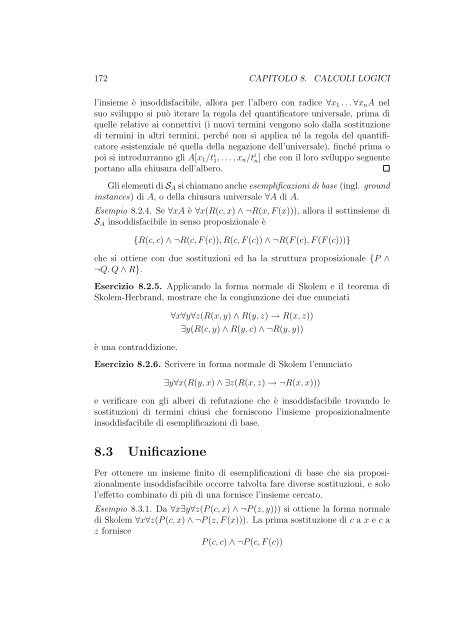Logica Matematica Corso di Laurea in Informatica ... - Mbox.dmi.unict.it
Logica Matematica Corso di Laurea in Informatica ... - Mbox.dmi.unict.it
Logica Matematica Corso di Laurea in Informatica ... - Mbox.dmi.unict.it
You also want an ePaper? Increase the reach of your titles
YUMPU automatically turns print PDFs into web optimized ePapers that Google loves.
172 CAPITOLO 8. CALCOLI LOGICI<br />
l’<strong>in</strong>sieme è <strong>in</strong>sod<strong>di</strong>sfacibile, allora per l’albero con ra<strong>di</strong>ce ∀x1 . . . ∀xnA nel<br />
suo sviluppo si può <strong>it</strong>erare la regola del quantificatore universale, prima <strong>di</strong><br />
quelle relative ai connettivi (i nuovi term<strong>in</strong>i vengono solo dalla sost<strong>it</strong>uzione<br />
<strong>di</strong> term<strong>in</strong>i <strong>in</strong> altri term<strong>in</strong>i, perché non si applica né la regola del quantificatore<br />
esistenziale né quella della negazione dell’universale), f<strong>in</strong>ché prima o<br />
poi si <strong>in</strong>trodurranno gli A[x1/t i 1, . . . , xn/t i n] che con il loro sviluppo seguente<br />
portano alla chiusura dell’albero.<br />
Gli elementi <strong>di</strong> SA si chiamano anche esemplificazioni <strong>di</strong> base (<strong>in</strong>gl. ground<br />
<strong>in</strong>stances) <strong>di</strong> A, o della chiusura universale ∀A <strong>di</strong> A.<br />
Esempio 8.2.4. Se ∀xA è ∀x(R(c, x) ∧ ¬R(x, F (x))), allora il sott<strong>in</strong>sieme <strong>di</strong><br />
SA <strong>in</strong>sod<strong>di</strong>sfacibile <strong>in</strong> senso proposizionale è<br />
{R(c, c) ∧ ¬R(c, F (c)), R(c, F (c)) ∧ ¬R(F (c), F (F (c)))}<br />
che si ottiene con due sost<strong>it</strong>uzioni ed ha la struttura proposizionale {P ∧<br />
¬Q, Q ∧ R}.<br />
Esercizio 8.2.5. Applicando la forma normale <strong>di</strong> Skolem e il teorema <strong>di</strong><br />
Skolem-Herbrand, mostrare che la congiunzione dei due enunciati<br />
è una contrad<strong>di</strong>zione.<br />
∀x∀y∀z(R(x, y) ∧ R(y, z) → R(x, z))<br />
∃y(R(c, y) ∧ R(y, c) ∧ ¬R(y, y))<br />
Esercizio 8.2.6. Scrivere <strong>in</strong> forma normale <strong>di</strong> Skolem l’enunciato<br />
∃y∀x(R(y, x) ∧ ∃z(R(x, z) → ¬R(x, x)))<br />
e verificare con gli alberi <strong>di</strong> refutazione che è <strong>in</strong>sod<strong>di</strong>sfacibile trovando le<br />
sost<strong>it</strong>uzioni <strong>di</strong> term<strong>in</strong>i chiusi che forniscono l’<strong>in</strong>sieme proposizionalmente<br />
<strong>in</strong>sod<strong>di</strong>sfacibile <strong>di</strong> esemplificazioni <strong>di</strong> base.<br />
8.3 Unificazione<br />
Per ottenere un <strong>in</strong>sieme f<strong>in</strong><strong>it</strong>o <strong>di</strong> esemplificazioni <strong>di</strong> base che sia proposizionalmente<br />
<strong>in</strong>sod<strong>di</strong>sfacibile occorre talvolta fare <strong>di</strong>verse sost<strong>it</strong>uzioni, e solo<br />
l’effetto comb<strong>in</strong>ato <strong>di</strong> più <strong>di</strong> una fornisce l’<strong>in</strong>sieme cercato.<br />
Esempio 8.3.1. Da ∀x∃y∀z(P (c, x) ∧ ¬P (z, y))) si ottiene la forma normale<br />
<strong>di</strong> Skolem ∀x∀z(P (c, x) ∧ ¬P (z, F (x))). La prima sost<strong>it</strong>uzione <strong>di</strong> c a x e c a<br />
z fornisce<br />
P (c, c) ∧ ¬P (c, F (c))




![Introduzione ai sistemi Wiki [PDF] - Mbox.dmi.unict.it](https://img.yumpu.com/16413205/1/184x260/introduzione-ai-sistemi-wiki-pdf-mboxdmiunictit.jpg?quality=85)











